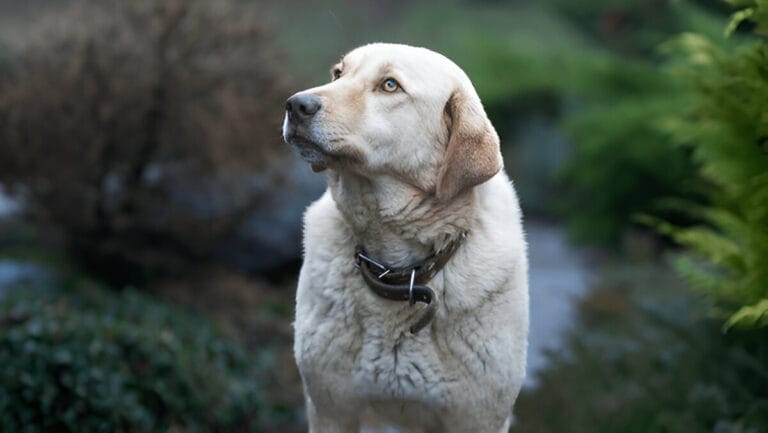What is a “Dudley” Labrador?
Over the years, I’ve been asked many times what Dudley means when people have sent pictures of their dogs to me. Owners wanting to know if their dog can meet this unique description often say they’re confused by the term.
Let me start by first describing the facts that make this Labrador no less beloved as a pet – and I hate getting mail from worried owners who aren’t assured that this name is actually a nice sounding word. The breed community has used this term to describe a specific condition without belittling your fur friend in any way.
When answering the question often posed about what defines a Dudley Labrador, the retriever simply lacks pigmentation in certain areas around the eyes, eye rims, muzzle, and nose.
People believe Labradors have reduced pigment in three types of noses – yellow, Black, and brown Labs can all show pink coloring that’s always referred to (or referred to) as liver in chocolate varieties.
Dudley Labrador are Labs that love to dig into genetics discussions because their pigment issues come from fascinating inheritance patterns. In my blog Lesson on Coat Color Inheritance, I explain how these beautifully marked dogs lack the black pigmentation usually associated with Retrievers in specific areas.
You can look at any color Lab from day one when they’re born right through old age, and in general, chocolate Labs show this case most often. Despite some disagreement among Labs enthusiasts, at the end of the day, the only real difference lies in pigmentation patterns that create these distinctive pink-nosed beauties.

Photo credit: Shutterstock by Badger13
Labrador Pigmentation Genetics:
All puppies are born with bright pink noses that usually become darker in color during the first few weeks of their lives. Yellow Labradors may remain the same pink shade while other Labs darken to only a light brown shade, and others turn completely black.
These different shades of a Labrador’s nose are produced as a result of density and type of melanin carried in the dog’s cells, which depend on genes the puppy inherited from both parents.
The B gene controls whether a dog produces black pigment – B creates chocolate coloring when paired with b, while Yellow coloration is controlled by E genes (Eee combinations). Understanding this potential helps explain how combined ee genes act like a switch that can override other colors.
There are one of three possible gene combinations in order: eeBB, eeBb, or eebb – each combination affects not only the coat color but still has contributing factors in determining nose pigmentation. Eye rims are also influenced by genes that turn a Labrador’s eye area pink, which puts greater emphasis on melanin in each cell.
Resulting pigmentation shown in skin creates paler tone and shading based on genetic backgrounds. When adult dogs are DNA tested, breeders can find which dogs carry the right genes to produce Dudley Labrador characteristics, though responsible breeders show that breeding two chocolates marked with this fault is discouraged in the ring.
This most commonly occurs when two chocolates are bred together without proper genetic background knowledge – while Dudley Labrador can occur in any chocolate lab breeding, it’s considered a NO-NO in serious breeding circles.
Many often inexperienced breeders need a thorough lesson in genetics – I recommend the Blue Knight Coat Color Inheritance chart which shows very LIGHT pigmentation patterns that come from BYC genes when strong genes from both parent’s lines create Chocolate Labs with medium to dark pigmentation.
You’ll well know that NEVER should green eyes appear, as the AKC breed standard considers this something you won’t see in proper Labrador breeding.
What Kind Of Personality Do Dudley Labradors Have? What Makes Them Special?
Intellect:
Like their chocolate, black, and yellow Labrador cousins, Dudley Labs possess remarkably high intellect and are very shrewd and clever dogs that learn and adapt quickly to new situations. Sometimes they copy the actions of people around them with such precision that it amazes even experienced dog owners like myself.
According to research conducted by an ecologist studying working Labrador abilities, one remarkable Labrador was able to collect twenty-six thousand bottles for recycling willingly by age six, demonstrating the incredible problem-solving capabilities and work ethic that these pink-nosed beauties share with all members of their breed – proving that pigmentation has absolutely no impact on their mental abilities or trainability.
Learnability:
Dudley Labradors are very good dogs for training, just like their more common colored relatives, and are capable learners – these labradors respond to education very well since they’re naturally obedient and love to learn new things.
A Dudley Labrador puppy with pink pigmentation learns to sit, stand, and perform other simple gestures easily, and even tries to understand words in addition to basic commands – they’re fast to pick up instructions and remember them for a long time.
These dogs are exceptionally eager to please and go above and beyond when rewarded with praise and treats, making them wonderful companions for families who want an intelligent, trainable dog regardless of their unique pink-nosed appearance.
Human-Oriented:
Dudley Labradors, including other labradors, are extremely human-oriented dogs that love their owner and also treat family members equally with devotion and affection. These pink-nosed companions will happily entertain babies and play with children of all ages, showing the same gentle, patient temperament that makes all Labradors excellent family pets.
Moreover, they become desperate and lonely when they miss their owners who leave for a long period, demonstrating the deep emotional bonds these dogs form with their human families – a trait that makes them wonderful companions but also means they need plenty of social interaction and shouldn’t be left alone for extended periods.
Sociability:
Labradors, including Dudley varieties, are incredibly sociable dogs that generally show warmth and greet visitors with genuine hospitality – they can easily recognize positivity and respond enthusiastically to praise for their friendly actions.
Thanks to their iconic personality traits, these pink-nosed Labs positively affect those around them by helping to calm you down and relieve your stress through their gentle, comforting presence.
This breed works best for lonely people who need a devoted companion – give them love, attention, and care, and they will return that affection tenfold, making them perfect emotional support animals and family pets regardless of their unique pigmentation differences.
Appearance:
Dudley Labrador usually have yellow coats where the shade and color depends on genetics – they can be pale cream or dark red in appearance. They feature short, straight fur that’s densely packed to create a stunning coat that’s identical to other Labradors except for their distinctive pink nose and eye rim pigmentation.

Photo credit: Shutterstock by Badger13
Black Labrador Nose Turning Pink
A Dudley Labrador will have a pink nose throughout his entire life, but many other Labs’ noses turn pink when they advance in years. This process is known as depigmentation and is quite common – it’s not usually a cause for concern among responsible owners.
When a yellow Lab is younger, he typically has a black nose with dark rims around his eyes, but as he ages, his coat begins showing little white patches in places that may also lose pigment over time.
The pigmentation in your Lab’s nose is produced by an enzyme called tyrosinase, which makes melanin for coloring.
Tyrosinase becomes less effective as a dog grows old, though you might find that the fading becomes more noticeable in warmer weather since the enzyme producing melanin works better in heat – this phenomenon is why some call it snow nose when its color fades as dogs get older in winter. You might hear it called Winter Nose too.
Also, strangely, I notice my girls get lighter noses closer to birthing a litter – their nose pigmentation gets lighter during pregnancy.
Then once the pups are weaned, it goes darker again, though I’ve never heard an official explanation for this – it’s just my personal observation.
This might be associated with hormonal changes, which could be the reason we see this pattern, perhaps due to body temperature fluctuations AND something I have personally observed when you cross certain genetic line combinations with another – some puppies develop freckles on their puppies’ bellies that fade with age.
I KNOW this sounds unusual, but any good breeder will NEVER dismiss unusual observations – I’ve found this pattern to be true over the past 20 years of breeding experience.
Pink Nose Problems In Labradors
It is worth noting that on rare occasions, a Labrador’s nose will turn pink due to a medical problem rather than natural depigmentation. If your Lab cuts her nose, the resulting scar tissue might be pink and not black or brown like the surrounding area.
This will normally return to its original color in time and isn’t a cause for concern, though any sudden changes in nose pigmentation should be monitored and discussed with your veterinarian to rule out underlying health issues.
The Problem With Dudley Lab Puppies?
Dudley Labradors are no different to their dark nosed Labrador friends in temperament and ability. However, if you are going to buy a Lab puppy with pink pigmentation, then you will need to be aware of a couple of things before bringing one home. Low pigmentation is linked to sunburn due to increased UV sensitivity, though this is not a big deal if you live in a mild climate and can discuss with your veterinarian how to help your dog reduce the chances of burning on those occasionally hot summer days.
The show ring also penalises yellow Labs for having pale noses, eye rims, and feet, so these dogs won’t succeed in conformation competition. But if you’re looking for a loving family pet or working dog, Dudley Labs make just as much of a wonderful companion and hard working friend as any other Retriever – their pink pigmentation doesn’t affect their loyalty, intelligence, or ability to be amazing family dogs.

Photo credit: Shutterstock by 9gifts
Should I Buy A Dudley Labrador Puppy?
If you choose to buy a Dudley Labrador puppy, then you will need to be aware of a couple of things before making your decision.
The first consideration is that they may suffer from sunburn on their pink noses during sunny weather, while the second issue is only relevant if you want to show your dog – the show ring penalizes yellow Labradors for having pale eye rims and feet.
So if showing is your goal, a Dudley lab is best avoided, but for families wanting a loving companion, these pink-nosed beauties make wonderful pets with proper sun protection.
Conclusion:
To summarize, a Dudley Labrador is a unique and rare breed of dogs that stands out from typical Labs. It has a positive personality that will love you unconditionally and get that affection back from devoted owners. The Dudley Labrador is the best loyal companion with wonderful traits including marvelous intellectuality, stunning memory power, and quick adaptability – making them a must-have addition that will bring joy and happiness into your life. For the first few years, it will be expensive to properly care for any puppy, but it’s worth having and choosing to keep this special labrador as your lifelong friend. If you want to know more about Labradors or have specific questions, feel free to contact us – we’ll have a detailed discussion about these remarkable pink-nosed companions.
FAQ’s
- Is a Dudley Lab a purebred?
Yes, a dudley is still a pure-bred Labrador Retriever – this pink nose trait is not an indicator of being a mutt. The unique color pattern occurs when both parents have specific yellow and chocolate genes that combine to create the lack of pigmentation.
- How much does a Dudley Lab cost?
Purchasing a Dudley Labrador can be expensive since they are very high quality bred dogs and considered quite popular among certain buyers. The prices tend to vary with these pink-nosed Labs because some breeders charge less than other labs, while this type typically costs about 480 dollars minimum to purchase from reputable sources.
- What is the lifespan of a Dudley Labrador?
The average Labrador Retriever lifespan is 11 to 13 years, and Dudley Labs follow this same pattern since they are generally a healthy breed, but there are some potential health issues that pet parents should be aware of regarding sun sensitivity due to their pink pigmentation.
- What is the most common cause of death in Labradors?
The main causes of death in Labradors are cancer, heatstroke, epilepsy, heart disease, and bloat (gastric torsion) – Dudley Labrador face the same risks with added sun sensitivity.















